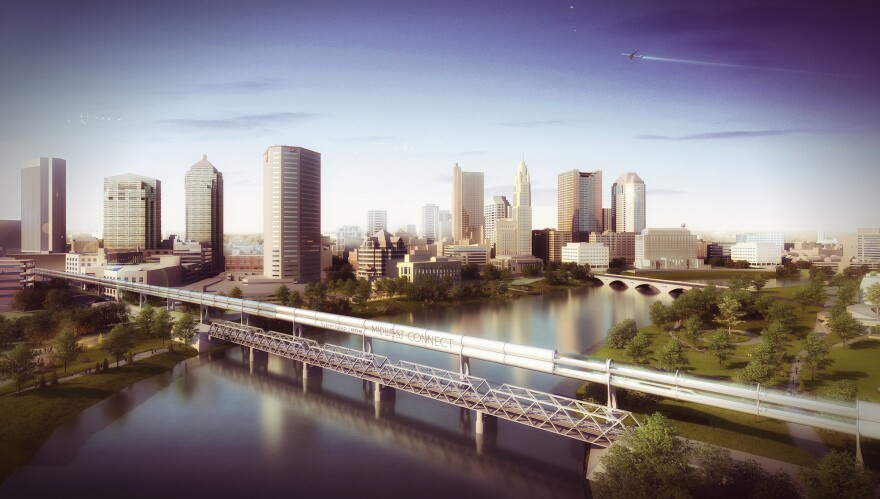Researchers are hard at work on two feasibility studies for hyperloop connections running through Ohio, including a route that could link Pittsburgh and Chicago with Columbus. There’s a strong current of optimism among many considering the technology, even if questions of cost and practicality remain out of reach.
Hyperloop evangelists bill the technology as the next evolution in transportation—able to move people and cargo at nearly the speed of sound. It’s half train, half plane, but—the argument goes—more than the sum of its parts.
The promise of moving hundreds of miles in a matter of minutes through a tube has many local leaders dreaming of hyperloop stations in their backyards—and Columbus is no different.
The Mid-Ohio Regional Planning Commission, or MORPC, is pouring about $2.5 million into studying a potential hyperloop route connecting Pittsburgh, Columbus and Chicago. Thea Walsh, who handles transportation projects for MORPC, explains they’re considering more traditional rail service as well.
“I mean, certainly we’re excited about the potential for Hyperloop, but that is yet to be proven,” Walsh says, “and there are no standards in the United States for that technology today.”
Walsh says feasibility studies from 2013 pegged the cost for rail service between Columbus and Chicago alone at about $1.3 billion, and those forecasts have almost certainly risen in the intervening years. Meanhile, Virgin Hyperloop One, the company MORPC has partnered with, contends its technology will cost less than rail.
But when it comes to dollars and cents, even hyperloop boosters have no illusions.
“I have no idea about the cost and I think it’s in such its infancy stage today," says Carlo Bailo, president of the Center for Automotive Research in Michigan. "But I can tell you right now, it’s not going to be cheap."
Bailo spent 35 years working for General Motors and Nissan, and worked at The Ohio State University researching mobility systems. She sees Hyperloop as a huge opportunity for Central Ohio, especially considering how much freight moves through the region.

But she’s realistic about the challenges. To Bailo, the biggest obstacle is making the leap from cargo to people.
“The G-forces,” she explains. “You know, there’s many things that can cause situations to happen that won’t be pleasant for the traveler—I’ll just put it that way.”
Late last year, Hyperloop One managed to get a test vehicle up to 240 miles per hour—comparable to, but not quite as fast as, the Shanghai maglev train. To make good on its claim to bringing passengers from Columbus to Chicago in 29 minutes, the company will need to crank top speeds up to about 700 miles an hour—just shy of Mach 1.
Bailo says that could take a while.
“I think, based on the current technology, we are at least 10 years out from a short way at full speed and safe enough for humans,” Bailo says. “I think it’s probably going to be 20 or 30 years before you’re going to see these habitrails really working well.”
Jeff Chin from NASA’s Glenn Research Center in Cleveland has worked on two earlier feasibility studies for the hyperloop, and he says the technology can work.
“You’re essentially flying very close to the ground and the vacuum tube can be considered kind of simulating the upper atmosphere almost,” Chin says. “So, rather than climbing up to a very high altitude, instead you bring that altitude down to ground level and then you fly through it.”
But getting to the highest speeds does present a difficult engineering problem.

“When you start moving at speeds close to the speed of sound it causes the air around you to accelerate even faster than that when it has to get around smaller areas,” Chin describes. “And so, when air is trying to move that fast, it can cause all kinds of problems in terms of causing shockwaves and noise and vibration, and that also leads to a lot of inefficiencies in terms your propulsion system.”
Still, Chin thinks it’s just a matter of balancing different inputs. One of his studies suggests the tube vehicles run through might need to be a bit wider, or the vehicles themselves might need to go slower. Either way, he thinks the tradeoffs are manageable.
The prospect of a Midwest hyperloop has drawn interest from around Ohio. In September, the Ohio Senate unanimously passed a non-binding resolution encouraging the development of a Columbus hyperloop, but without dedicating any money to the project. And recently, the Northeast Ohio Areawide Coordinating Agency commissioned a feasibility study for a rival Cleveland-Chicago hyperloop, a route that would take about 28 minutes one-way.
MORPC is currently accepting bids for its own feasibility study—with an eye on having the report completed about a year from now. Whether a Columbus hyperloop station is actually in the cards, and how much it’ll cost to build, will have to wait until then.







